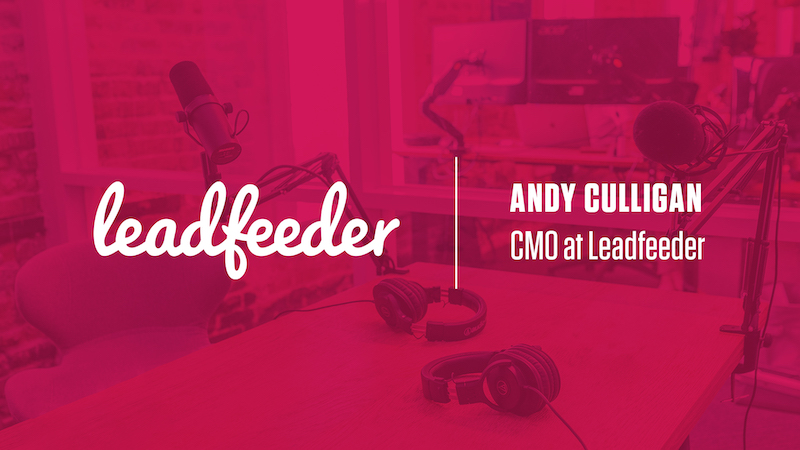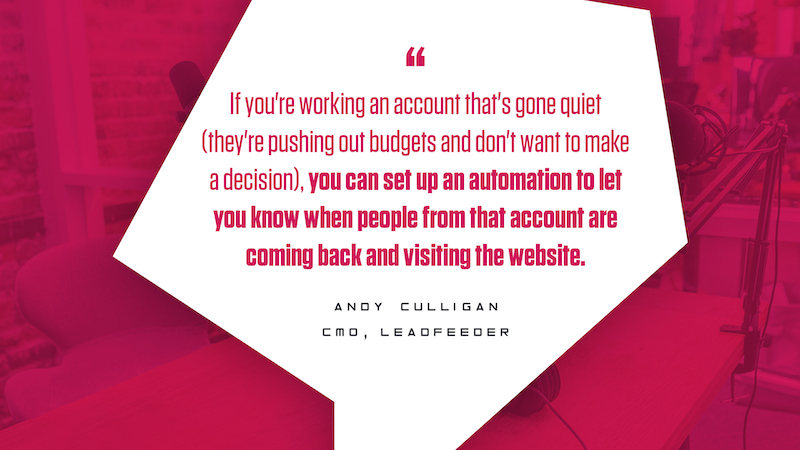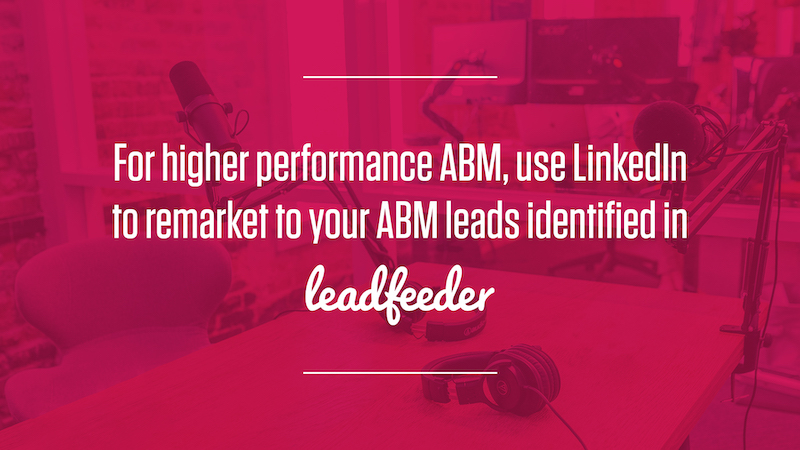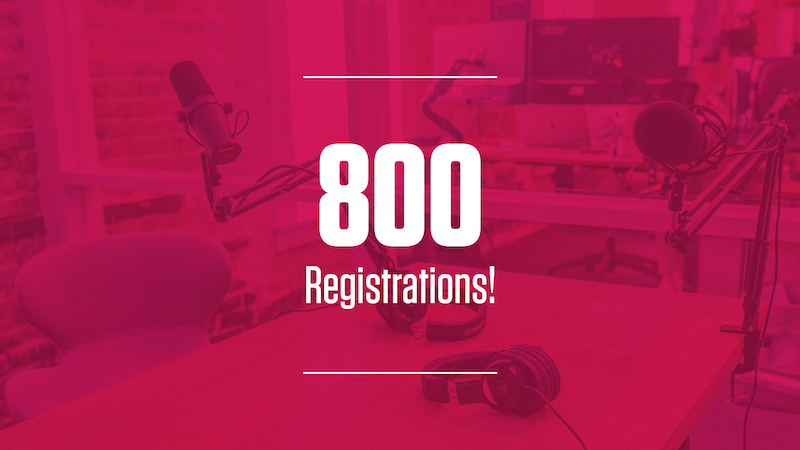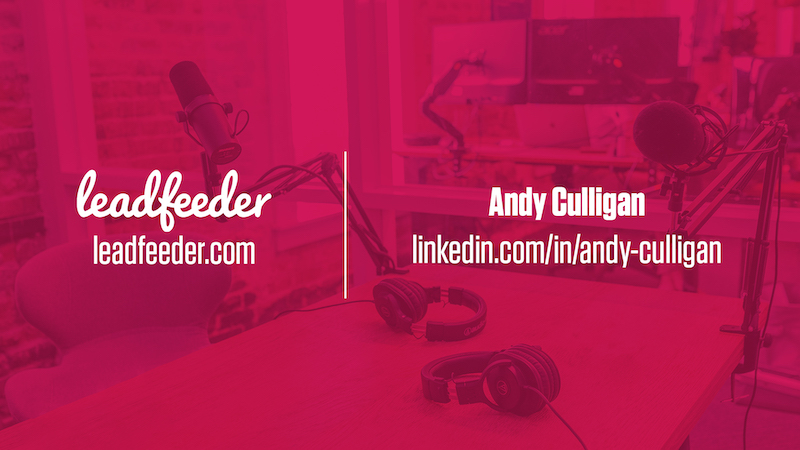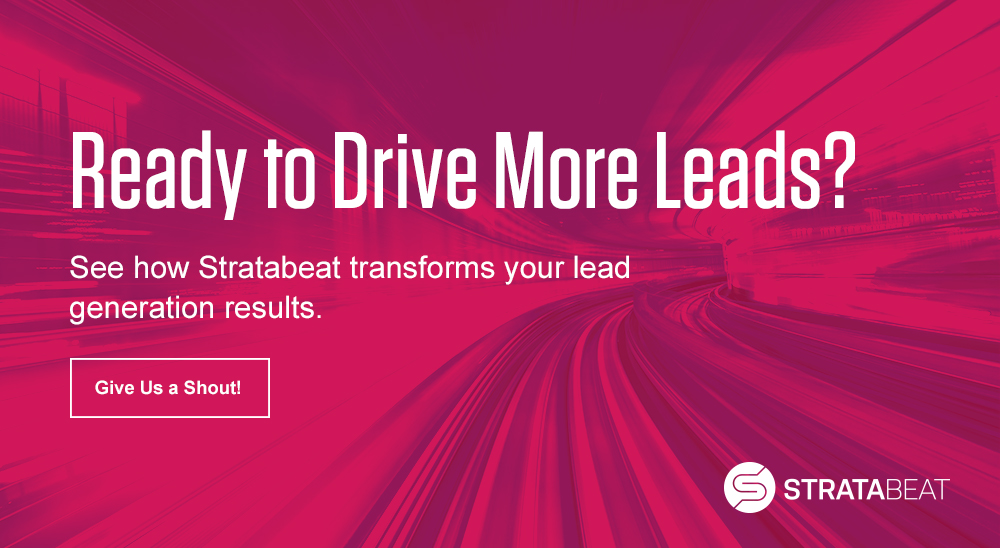Lead Gen Hacks from Leadfeeder’s Andy Culligan [Interview]
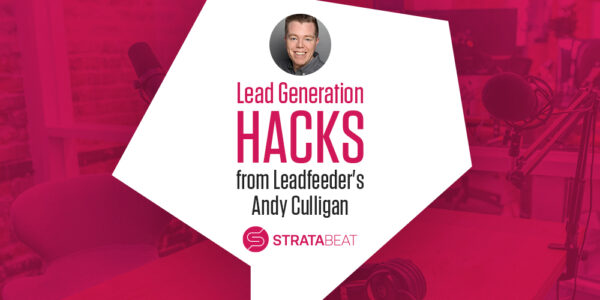
In this premiere episode of Stratabeat’s B2B Marketing Tech Talks, Stratabeat CEO Tom Shapiro talks with Andy Culligan, CMO at Leadfeeder, to learn about Culligan’s freestyling, fearless and highly effective lead generation hacks.
Through the interview, the two discuss the many benefits of Leadfeeder in helping companies to identify who’s on their website and to make the data actionable.
They also explore Culligan’s impressive lead generation initiatives for Leadfeeder itself. Two-thousand webinar registrations in just three days? Yep, Culligan’s been there, done that.
Watch the video or read the transcript below, and uncover new ways to increase your leads.
Interview Transcript
Tom Shapiro:
Welcome everybody, really glad to have you here. Today we’re going to be interviewing Andy Culligan, CMO at Leadfeeder. Now Leadfeeder is an awesome application. We use it here at Stratabeat every single day. It’s essential to our martech stack, and I personally use it every single day, so I can attest to how awesome the application is. So, what Leadfeeder does is, it turns anonymous website data and traffic into actionable data. And well, Andy can tell you much more about it. Welcome, Andy.
Andy Culligan:
Thanks, man. Really great to be on.
TS:
So Andy, why don’t you tell us a little bit about yourself and a little bit about Leadfeeder?
AC:
Okay. Yeah, sure. No worries. So about myself. So I’m Irish, I’m clearly not living in Ireland though, as you can see, because I’m sitting outside at the start or middle of August. In Ireland right now, I guess it’s raining. I live in Vienna, Austria where it’s now 30 odd degrees, in U.S. dollars that’s about 90 something degrees. So, that’s why I’m sitting outside.
Yeah, so I’ve been in the martech space now, six, seven, eight, maybe eight years or so. Doing many roles that are focused on lead generation, demand generation. Prior to my roles at Leadfeeder, I worked for two other companies, which were in the tech space. There’s Emarsys, who are a marketing automation platform for retailers. And then also in the same space with a company called Exponea where I was a VP of marketing there, so I built up a global marketing team. During the time I was there, we focused on tripling, quadrupling the revenue size. So going from… Really it almost quadrupled in terms of size from an ARR perspective. But as a workforce perspective, we scaled the company from 80 employees to up over 300 employees in the space of like 20 months. So the scale of business is where I really fit in best.
Prior to that, I’ve done all types of roles. It’s funny. I started working when I was 14 and started doing terrible sales jobs and working in grocery stores. And I’ve done all types of odd jobs, but what my first real job was was an SDR. So, the one job that most people don’t want to do. So it’s funny, I always say, I’ve met a lot of SDRs, I’ve met hundreds of SDRs during my career and I’ve only met two that actually wanted to be an SDR.
TS:
That’s hilarious.
AC:
So, it’s the job where everybody’s trying to earn their stripes in order to get a sales role. So I did the thing where you get the, our boss at the time used to call it PFOs. And a PFO call is when you pick up the phone and somebody tells you nicely to please F off, so that’s a PFO call. So, well rehearsed in that side of things.
And yeah, so I did the SDR piece for a couple of years. I worked down in sales key account management for a couple of years. Then I also decided, I had studied marketing, so I said, “Okay, I want to get back into the marketing side of things.” Because although I enjoy sales, it’s been interesting. As I said, I worked in all types of jobs. So I sold cutlery, I sold gym memberships on the streets, working off commission only. I’ve worked selling in carnivals in South Carolina, would you believe? Myrtle Beach?
TS:
Wow.
AC:
Yeah. Yeah. Yeah. I didn’t quite go as far as being a fill-the-gas-er, but it was close.
TS:
But I’m sure you have stories to tell.
AC:
I have a lot of stories to tell. Let’s say they’re probably best told offline, but yeah. So, my main focus is alignment between marketing and sales, because I have that experience from the sales org and also, I’ve also managed under the marketing org, the SDR team down at my previous company.
I really understand the needs and the problems that an SDR or sales team face. And I try to get as close to them as possible. So with our CRO here at Leadfeeder who runs the sales org, myself and himself probably talk 10 times a day. And people ask me, “How do you get aligned?” I said, “Just communicate. Communicate, communicate, communicate. They need to know what you’re doing and you need to know what they’re doing.” And if there’s a lack of that communication, then you can forget about alignment.
TS:
Yeah. It’s so important. Yeah. What you’re saying is so critical because so many organizations, sales and marketing, they run in isolation from one another. They run in silos, and you just see the disconnect all the time.
AC:
And I tell you what happens with that, and I’ve experienced that with a number of organizations is that the salespeople come out and start creating their own messaging. And then the salespeople have it in their mind, “Ah, our marketing team are sh**. They don’t know the product. They don’t understand what we’re seeing at the cold phase when we’re going and speaking with prospects and clients. They don’t get it. Yeah, whatever about their blog posts or whatever.” So nobody’s been successful with it.
TS:
Right. Right. Yeah.
AC:
Marketing are churning out stuff that the sales team don’t want to use. Sales team are super demotivated by the stuff that the marketing team are pushed out. Sales team are wasting their time coming up with their own messaging, which is probably not on brand. Everybody’s gone ahead and created their own stuff. And it just turns into a lot of wasted time and a lot of de-motivated employees.
TS:
I agree.
AC:
Yeah. So, that’s my core focus.
And then from a Leadfeeder perspective, I’ve been with Leadfeeder now since December of last year. And for me, it was almost like a no-brainer. I’ll tell you why, because I’ve been working in the space where I’ve been selling or I’ve been in marketing to B2C marketers. So the last two organizations that I really earned my stripes in from a tech perspective, that I spend over five years at in senior marketing positions, was still communicating to B2C marketers. And Leadfeeder’s a B2B tool. So I had always being a B2B marketer. I’ve never been a B2C marketer. I’ve dabbled in it, but I’ve never had the same problems that a B2C marketer faces. Because they’re similar problems to a B2B marketer, but it’s not the same.
TS:
Right. It’s not the same at all.
AC:
You can’t compare somebody that’s… Exactly. If you’ve got a brand, let’s say American Apparel or something like that, and you’ve got somebody that’s their digital marketing manager or the head of marketing, your CMO or whatever, that person’s problems that they’re going to face in terms of what they need to be focused on on a daily basis, what their targets, KPIs, et cetera, are, are going to be fundamentally different to what mine are as a B2B CMO. So I’m got to be focused… The difference would be that I would be focused on… Okay. Both of us would be focused on revenue probably, but the way in which we get to our revenue is going to be very different.
So my message, I found it hard for my message to resonate with those marketers. Now it worked and it’s impossible to find someone from the B2C space and put them into the B2B space and expect them to do the same. I think the problem with that specific thing going from B2B to B2C thing, is that there is a bit of an area there that doesn’t really work.
But now, after moving to a position where I fully get the pain point of the customer, I’ve been the customer, I’ve had the pain points. I fully understand why the tool needs to be used, where it needs to fit in, what specific use cases could be, etc., etc. And with that even, I can get my team based on my experience to be like, “Okay, this is how we should use Leadfeeder to do this, this, and this.” And they’re like, “Where did you come up with that?” I’m like, “Because I’ve been using tools like this.”
TS:
Yeah, that’s great.
AC:
You have to learn, in order to get the most out of many tactics, you need to know how to hack them. It’s the same what I do. Leadfeeder is not different. If you can hack it, then you can get massive value out of it. Out of box, it offers value, but if you can really hack it and do some really interesting use cases, then it’s a super tool. And just to touch on a point about what we actually do is, we show the intent of the accounts that are coming and visiting your site.
So look at the companies that are coming, what they’re looking at, where they come from, how long they spent on site, how many people have come from that specific company, what their location is, et cetera, et cetera. So giving you core intelligence, which a lot of companies would probably overlook. Okay? So I call it first party intent data, you’ve probably heard of third party intent data, which a lot of companies like Bombora for example, would be doing, demand-based, another one that wouldn’t be looking at a lot of third party intent data. And third party intent data basically is looking at intent signals from across the internet. So let’s take, for example, somebody from Microsoft has been searching for a marketing automation platform and that search query would then show up as basically, somebody from Microsoft has been searching for marketing automation, therefore Marketo might be interested in that.
That’s a super high level example there. I’m actually doing that no justice whatsoever. Whereas first party data is the data that you own. So it’s people coming to your website, interacting with your content, knowing your brand, knowing what you’re about. And then what you can do is the more that people come back, the more you can score them. And then basically what we show is, “Hey, these ones are showing particularly high intent because they’ve come and looked at the pricing page, which is a good intent signal. They’ve also come and looked at 12 different blog posts. They’ve done X, Y, Z.” And then we show the company and the location and the number of people that have come.
TS:
Right. And I think another advantage of the intent data that Leadfeeder brings is, it’s so timely. It’s real-time. I can see what they were doing this morning. I can see what they were doing yesterday. And I can see exactly when they were doing it, how many of them were doing it, what each one was doing. It’s just so timely. You just can’t beat it.
AC:
Exactly. And if you’re a sales person and you’re working an account, a good use case is you’re working an account that’s maybe gone a little bit quiet, especially during these times. People, they’re pushing out budgets, they don’t want to make a decision and it’s gone quiet. You can set up an automation or a notification to let you know when people from that account are coming back and visiting the website. So you get an almost immediate, a couple of minute delay, almost an immediate notification to say, “Somebody from company X, Y, Z has been coming and looking at the site.” And then you can dig in and see what they’re looking at and that will reopen the conversation.
TS:
Yeah. And that’s especially important for any B2B marketer that’s doing ABM marketing. That’s invaluable.
AC:
For sure. Yeah. And ABM, there’s a couple of interesting use cases. We use it ourselves within our ABM campaigns. So we have our total addressable market list already mapped out. Okay? And with that, what we’ve started to do is take the Leadfeeder data of anybody that’s been visiting from specific companies to the site, extracting that information and then pulling it into LinkedIn to retarget them. So we cross reference it back to our total addressable market list, which we have already uploaded into Leadfeeder. And then it’s doing a match when one of those companies comes to your site from your total addressable market list. And then what we’re able to do is then extract that information out to retarget them even further.
So you give it across to the sales team as well, but at the same time, you also then get the… Sorry, just got a phone call there, need to hang up. You can push that across to the sales team and get the sales team to also do a followup whilst the design team retarget them from a marketing perspective. So it’s a bit of a double edged sword there.
TS:
Yeah. Yeah. Very effective, very effective. Now, so this is one use case. Can you give us another really interesting use case of Leadfeeder that you’ve seen among your customers?
AC:
Sure. Sure. So we’ve actually copied this one recently. We’ve taken it from one of our customers. So you learn a lot from your customers. One thing that I’ve asked my team a lot of recently is like, “Oh, when was the last time you spoke with a customer?” Like, “Oh, I don’t know, six or seven months ago.” And I’m like, “You should be speaking with a customer every two weeks. Every two weeks.”
TS:
Right.
AC:
[inaudible 00:12:45]. “Well I don’t know anybody.” I was like, “Make friends with the customers.” Okay, I know we can’t be going and bringing people out for drinks and stuff at the moment, send them something to their house, do something, get to know them. And I’ve really started to encourage that. So things like this come out and we’ve started to copy what our customers are doing because it’s super interesting.
So there’s one specific use case that we’ve been doing on our competitor ad campaigns. So what we’re doing is we’ve seen that anybody that clicks through on one of those competitive ad campaigns [inaudible 00:13:17] from Google, is more likely to turn into a paid customer than any other of our sources or channels. Now in my opinion, it’s pretty clear why the reason behind that is because they’re informed, they know the market, they’ve been doing their research, they know what they’re looking for because they’ve been searching for specific competitors. Okay? So in layman’s terms, they searched for a competitor of ours, they end up on Google, we bid against their keyword. So competitor X, we’re bidding on that keyword, competitor X, right? And then they end up clicking on our ad and they end up on our landing page rather than competitor X’s landing page. Okay?
Now, whatever the conversion rate on those pages is, you’re getting a certain percentage of people that will then give you their details and sign up for a trial. And then you’ll get a big chunk of people that won’t. That’s the same with any ad campaign, right?
TS:
Yeah. Sure.
AC:
But you’re still paying for those clicks. You’re still paying for people to click through on those ads and they’re not cheap. So what we’ve started to do now is we’ve started to look at those companies which are clicking through on those competitor ad campaigns and understanding what competitors they’ve been clicking through on, we’ve got that intel because we know that the keyword that they’re searching for, that’s pulled into Leadfeeder as well. So we know it’s like prospect, whatever, let’s say… I don’t know. Let’s say Stratabeat, right? Stratabeat have come through, they’ve looked for a competitor of ours, let’s Lead Forensics, they search for Lead Forensics. There’s me giving my shout out to Lead Forensics here, I’m a bad CMO.
They’ve searched for Lead Forensics. What we can see then is in Leadfeeder, we can see, okay, somebody from Stratabeat had clicked on the ad campaign, their keyword search was Lead Forensics, we know that anyway because they’ve clicked on Lead Forensics campaign, but they haven’t actually filled out the form. We know where they’re based, they’re based in Boston. We know the type of user that we were pushing that type of ad to. So it was to a sales person, marketing person, for example. Then what we can do is we can make a fairly good assessment judgment, say, “Okay, let’s follow up with these three or four people from Stratabeat.” After we do our research within the tool itself, there’s also the contact feature.
So with that as well, you can get some really good intel, like when you’re following up and say, “Hey, Leadfeeder offers this feature, whereas Lead Forensics doesn’t. Leadfeeder has these particular types of contracts in terms of pricing and what type of contract we want you to sign versus what Lead Forensics doesn’t have.” And you’re able to base your conversation there off of, what are the competitive battle points against your competitor? That’s one use case that works really well for our customer. We’ve just started it now and it’s actually starting to turn up some good business for us as well.
TS:
Excellent.
AC:
And something that it took two or three minutes to set up. We were already doing the competitor ad campaigns. So, why wouldn’t we want to have that additional intel as well? That’s the thing, from our customer’s perspective and from our perspective like, you already have all of that data, you’re just not looking at it. And it’s just not presented to you in a meaningful way. And all we’re doing is taking it and showing it to you.
TS:
Yeah, you’ve nailed it. So, that’s really cool. I also want to talk about Leadfeeder’s marketing. So the marketing that you’re doing yourself, because I’m very impressed with a lot of things you’re doing. And one of the stories that you’ve told me is about the success of the webinars that you’ve launched this year. And so I was wondering if you could share with the audience just what you were doing and some of the successes that you experienced.
AC:
Oh yeah. So I even shocked myself in terms of how good they were, to be honest with you. I’m still a little bit shocked. “But let’s keep that between you and me,” he said while recording a video. But yeah, I think, look, it was really a right place at the right time with those and also our guests. So, let’s start at the start. At the start, it really was right place, right time. Okay? And there was a bit of luck that played behind it.
So let me tell you about how it started. So it’s a pretty interesting story. So a buddy of mine, Alex Olley who’s the CEO, or not the CEO, he’s the co-founder of Reachdesk. Reachdesk are a direct mail company, I don’t know if you’ve come across them. But they’re very big in Europe and they’re making their entry into the US now. They’ve got a presence there in New York. But I was actually talking to Alex on the, I think it was the 16th of March. No, the 14th of March. It was the 14th of March, it was a Saturday.
TS:
Okay.
AC:
It was a Saturday, right?
TS:
Yeah.
AC:
And the fact that I know the date just goes to show how much I’ve been thinking about this. So, we got chatting and we were just texting, and I asked him, “How are Reachdesk getting on?” So Trump just announced, I think on the Thursday, which was around the 12th, that they’re going to be closing the borders in the US and that’s when the world really started to panic, I think. We went into lockdown a week later here in Vienna in Austria or maybe actually a week beforehand, we went into lockdown actually. And that’s when around the US started to go into lockdown.
But I was talking to Alex and I said, “Look, how are things going at Reachdesk?” And he says, “Oh, there’s a little bit of fear, but things are moving. I’m just at JFK at the moment trying to get the hell out of the US.” I was like, “Ah, sh**. You’re in the US, you’re trying to get out. That’s interesting.” “No, I’ve got a nine month old at home and I don’t think my wife’s going to be too impressed if I get stuck over here.” And so I said, “Okay, well, look…” We both just sort of came to it, like, “Hey, let’s take advantage of this a little bit and let’s do some content.” And I never shy from content, I’m always pushing stuff out. I try to record as many conversations that I have with people, maybe it will become a podcast, maybe we’re pushing out a video on LinkedIn, but always trying to get as much content as possible because you never know what the gems are going to be.
A lot of it’s just going to be garbage, but some of it really sticks. And with that, we had a chat then. We finished with that conversation and started, “Hey let’s chat on Monday.” So Monday morning, he was back in the UK and we had a quick chat. And we said, “Okay, well let’s try a webinar.” And I said, “Well, the key here is, Alex that we need to get it like ASAP.” And then he said, “All right, how about Thursday?” I said, “Yeah. Okay. Let’s do Thursday.” So we said Thursday evening, so we’ve got a US audience as well. And then it came to the topic and I was like, “Okay, well what’s the number one fear for salespeople at the moment?”
And everybody was like, “Oh sh**. My pipeline is going to completely dry. Nevermind what I already have in the pipeline, but trying to create new pipeline. We’re coming up to the end of March now, how in the name of hell am I going to be able to create pipeline in Q2? The whole world is shut down. What’s going to happen?” So we just said, let’s address that point. And we called the topic, “Keep calm and create pipeline.” And we started pushing it out via numerous channels. So we started the push on the Tuesday morning. And I got Johnny, one of the guys on my team, I don’t know if you’ve spoken with Johnny before, but Johnny Butler is, I nicknamed him the Wizard of Oz of Webinars. He’s the man behind the scenes that makes all the things happen.
TS:
Awesome.
AC:
And for him he’s like, “Oh Andy, not another one. You’re killing me.” [inaudible 00:00:21:14]. “Yeah man, you’ve got to work.” I’m the one that comes up with the great ideas and he’s the one that actually makes them turn into magic. So it’s actually Johnny should be the one you’re talking to here.
Yeah. So what happened then was we started pushing it then on the Tuesday and then Johnny, who I just mentioned, he’s my head of demand gen, and then also Dara who’s our head of growth, just started texting in our Slack channel, being like, “This thing is blowing up, man.” And I was like, “Oh, interesting.” So, myself and Alex had done a webinar together on ABM back in December and we got, I think like 300 registrations or something, which was very high for a webinar. 300 registrations isn’t bad.
And this one, we pushed out on Tuesday morning and by Tuesday afternoon, we’d already had like 400. And I was like, “Huh, okay, this is going to the right direction.” Then by Thursday by the time that we actually sat down and did it, we’d had like 800 registrations or something.
TS:
That’s great.
AC:
Just from pushing out a couple of emails, pushing some stuff out on social. And this whole thing, it really helped everything. The entire internal team dynamic, the sales team were like, “This is amazing. This is the best thing I’ve ever seen.” And I was just pumping out messages to the sales team being like, explosions and being like, “We’re going to do it. Let’s get another 100 on.” And the sales team were like, “Yeah, let’s go do it.” During a time where people were really concerned and really worried, people were like, “Yeah, let’s do it. It’s going to be awesome.”
And then on for the webinar itself, I think we had, I know it was 800 registrations, we nearly got 500 people on, which is-
TS:
That’s awesome. That’s amazing, yeah.
AC:
I remember that day, because at the end of the day, you’re speaking in front of 500 people and you’re like, “Oh sh**, is this content going to be good?” I spent a day putting it together and last minute Alex was like, “Hey, do you mind if our CEO comes on and he does a bit as well?” I was like, “All right, let’s see where that goes.” And then Mark came out, he did a… It just all worked. It just sort of followed in, it all just worked.
And so we had that and then straight after that, I was like, “You know what?” I called Johnny immediately afterwards, it was like 7:00 PM or something in the evening. And he was like, “Okay, great. Yeah. Time for a beer now after the work over the past couple days.” I was like, “No man, we need another one for next week.” He’s like, “Okay.” To be fair to Johnny, he was like, “Okay. Yeah. Sounds good. This makes sense to do.” Johnny is one of those guys where I throw a lot of ideas off of and he tells me if they’re utter sh** or not. He’s the guy that will say, “Okay, Andy, this is good. This is not.”
TS:
You need someone like that, someone that’s super honest, transparent.
AC:
Absolutely. Absolutely. But super respectful about it as well. It’s like, “All ideas are good, Andy. It’s great to have ideas, but…” “Okay, Johnny, as soon as the but come in, we’re scrapping it. Okay. We’re done.” But he was fully behind it as well. So I said, “Okay, let me look into my network to see who I can tap into to see who’d be interested.”
A couple of weeks prior to that, Aaron Ross had been texting me saying… I don’t know if you know Aaron. Aaron is the author of Predictable Revenue, which is basically like the sales Bible of Silicon Valley is what it’s called. And he was the person that built up the SDR function at Salesforce. So brought them from a $10 million to a $100 million organization.
TS:
Nice.
AC:
So Aaron’s an interesting character, Aaron’s a good guy. And we’d been doing some business together over the years and Aaron was looking to piggyback on other companies that were in the sales space, which had a relatively large following, that had high traffic volumes. We get nearly 100,000 users to the site a month, so he’d obviously heard about that and saw it. So he’d reached out and said, “Hey, I really like your content. We should do something.” And that was a couple of weeks prior to that and I’d done some business with Aaron in the past and I’d met him a couple of times.
AC:
I met him at a SaaStr Europe a couple of years ago and we just got chatting. And we just got along. I refer to him almost as a mate there. And I pinged him and I said, “Hey man, we did this webinar. It went really well. Do you want to come on next week and we’ll do one again?” And the topic was about SDR’s do’s and don’ts, I think it was, we made a couple with Aaron. And that registration got 2,000 or that one got 2,000 registrations in three days.
TS:
That’s awesome. Not too bad, not too bad.
AC:
But I tell you what though, so that was from the Monday to the Thursday. And we had it the same time Thursday, stick with a winning team. And we launched that and 1,000 people tried to join at once and the whole service crashed.
TS:
No. No.
AC:
Yes. Yes. Yes.
TS:
So what’d you do?
AC:
It hasn’t been without heartache. So I’ll tell you what we had to do, so what happened was the whole service crashed and a couple of things happened. It didn’t work then properly for the entire session, only about 200 people could get on. And then what we needed to do is we rescheduled it. So we did it and then we did it again a week later, or not even a week later. We did that on the Thursday and did it again on the Tuesday and then I had another one on the Thursday. So we pushed it again to the same audience saying, “Hey, we’re going to redo it. Sorry about that.” I think we got still 1,000 registrations for the second one.
TS:
Yeah. That’s still amazing.
AC:
Yeah. So we reran it. We went through the process of changing our webinar provider.
TS:
That was a good move.
AC:
Yeah. As I said, it wasn’t without some heartache. We were doing things so by the edge of our seat, almost, that there was bound to be problems, right? There was no way that things were going to go that smoothly. Look, it’s worked out so well. And we’ve calmed it down now during the summer. But what we started to see off the back of Aaron was, because everyone’s like, “Oh sh**, you got Aaron Ross on. How’d you get him on?” And it was just really, for me, knowing him from the past and him reaching out. And it was like a calamity of events that came together that just enabled us to get that.
TS:
Yeah. Beautiful. Yeah.
AC:
And then other people just started hearing about us and you seeing my post on LinkedIn and then people were reaching out to me. But then it got to another level where I needed to be doing proper outreach to people, like I was an SDR again. So I was cold calling people, cold emailing people, cold LinkedIn messages, trying to go in through my network to other people, intros to people and so on. I was basically being an SDR, I spent half my week trying to get guests on.
But it was super interesting. We’ve had some great guys on like KD Dorsey. He was a great one. That was another one with… So KD and Daniel Disney, where they came on. And again, it was like 2,000 registering.
TS:
Amazing.
AC:
And again, 1,000 people on, and 1,000 people on, 800 people stayed on for an hour and 15, an hour and 20 minutes.
TS:
That’s unheard of. That’s amazing.
AC:
And it was nothing to do… So it turned into this, it was nothing to do with the content that I was coming up with or pushing, it was the direction that I wanted to push, but the guys were the ones that were really selling it. So my point was like, “Guys, I want you to just come and give value to the audience that’s focused on this topic. I’ll give a bit of an intro, but then it’s up to you guys. Take this as your stage, you preach your message.” And people started asking, “Hey, should we not put the Leadfeeder product in a little bit more? Talk about Leadfeeder more?” I said, “No, I think in this case, I think the best pitch is no pitch at all.” And we’ve managed to grow our database by, I think we’ve managed, it was at 11,000, there’s something like 8,000 or 9,000 which are net new.
TS:
That’s amazing. Yeah. Yeah.
AC:
For free. We only spent like a grand. We spent a grand.
TS:
That’s insane. That’s just insane. Yeah, that’s incredible.
That’s a great story.
AC:
It’s been an interesting journey.
TS:
Yeah. Yeah. Well, yeah, really, really impressive what you’ve done with that. All right. So, that’s a look at what you’ve been successful with this year, just amazing.
But let’s turn to the future. So looking into the Andy Culligan crystal ball, what do you see for lead generation for B2B marketing? What are big changes that you might foresee over the coming year or the coming two years, coming three years? What are some thoughts that you have?
AC:
So yeah, I think people need to stop with the top of funnel bullsh**, to be honest. Honestly, look, this is nothing new, but the top of funnel stuff is real vanity stuff. People are seeing through that massively. Even look at the changes and such that LinkedIn have made recently to their algorithm, it’s to get rid of those, “I can 10X your website traffic in two hours.” To get rid of those phony experts that have managed to get these large bases, but basically just spread bullsh**. And I think that’s going to start trickling down into content. And I think that content is where it’s really going to be at in terms of adding value. Whoever’s going to be able to add the most amount of value and content without actually charging people for it is going to win.
You’re starting to see people do these Patreon groups and so on to give additional insights and additional content. I think we’re going to start seeing more of that. And then eventually, that stuff will start moving away from those Patreon groups and start coming out into the real world. And I think you’re going to start seeing brands be a lot more fun and a lot more interesting. You’re not going to have stuffy brands anymore. One brand that I’m really, really excited about and really interested in at the moment is Gong. Gong.io. And I’ve been speaking with the guys at Gong, we’re doing a webinar with them in September.
TS:
Oh, nice. Nice.
AC:
So, of course, you have to get them on. No, but they’re taking things lighthearted, they’re offering real value in the content that they offer, but they’re also making it super interesting. There’s so much boring sales sh** out there at the moment. It’s boring. You’re putting people to sleep. And I think it’s really about adding value, but keeping people excited as well, because there’s such a massive amount of content that’s come out in the past six months alone just because of COVID. [inaudible 00:32:44] double it down with the content approach. But there needs to be a certain humor to the content. Like the webinar things that I was telling you about that we were just talking about, I guess you’ve been on some of them, but they’ve all been quite lighthearted. There’s no stuffiness. People are taking the piss. People are cursing on it, whatever. It’s just fun, but it’s turning a situation or it’s taking valuable, actionable advice and making it into something that people will listen to because it’s interesting. It’s put out there in a fun way.
I’ve been speaking with a couple of guys about this this week because I’ve in the background started to record a podcast. We haven’t released it yet, you’re the first person in the outside world to find out about it. We’ve done a couple of episodes already, but it’s really, all it is is us just talking business, but at the same time in between trashing each other a little bit, and giving out about things here and there, but it’s fun. We’re having fun. I don’t know if it’s going to work, like I said to the guys, who knows if it’s going to work? But let’s push it out there because the last thing that people need is another stuffy sales podcast. This is the Challenger Sales Methodology and this is how you… Come on. Nobody cares.
There’s too many people out there that are claiming to read all the business books and listen to all the business podcasts. I don’t fully believe it, I think that’s all… Again, vanity, showing off. I think it’s not true. And I think, if you asked me what the next years are going to look like, I think it’s people are going to be looking for truth and things, wanting to see a little bit of the personality come out. That’s what I try to do on LinkedIn and that, those posts tend to work pretty well for me. When I just start calling bullsh** on things.
Like I said, there was a recent one that I did where I said like, I started the whole thing off being like, “I got up at 4:00 AM, made myself three cups of bulletproof coffee. I then did yoga for an hour and then I did Vedanta training, read half a book, wrote my diary for the next week, did all this.” I said like, “Actually what happened was I got up at 07:00, fed the dog, brought him out to the toilet, brought him for a walk, came home, fed the kids, started working.” That type of thing, “Got up at 04:00 with the sunrise. And I’ve been fasting for three days and that’s how you be successful.” That whole thing is going to be found out, and it’s starting to be found out. It’s not true. It’s whatever works for you.
TS:
Yeah. That’s awesome.
AC:
If I was looking into a crystal ball, I think people are going to expect brands to be more real.
TS:
Yeah. I think that’s spot on. And I remember that post that you posted. Well, awesome. Awesome. Well Andy, thanks so much for joining me. It’s been fantastic. Again, I think the world of Leadfeeder. I think it’s a fantastic solution. We use it every day. So, before we sign off, can you just tell people where should they go? Where can they find out more about Leadfeeder or where can they connect with you?
AC:
Sure. So people can go to leadfeeder.com. Real simple. You can sign up for a free trial. So we do a two week free trial. So you can’t actually buy the product until you’ve seen some value out of it. So we fully believe that the best way in order to make sure that you’re going to use the product is to start to see that initial value because we don’t want to have customers on board that don’t use the product because they’re just going to churn. They go, “Why am I paying for this anyway?” So we encourage you to use the product for two weeks.
Once you start seeing some value in there, then after that two weeks, you can then upgrade or you can stay in a free light version with very limited features. But yeah, you can sign up for the free trial at leadfeeder.com. Real simple. All you need to do is install a tracking script on the head of your site, takes two minutes to install. And once you do that, we already start tracking the visitors to your site.
You can find me at LinkedIn. I’m very active on LinkedIn, so you can find me under Andy Culligan. And yeah, if you have any questions, anything at all, just reach out. I’m always happy to shoot the breeze about marketing topics, sales topics, whatever it might be.
TS:
Perfect. So thanks again everyone for joining us. And Andy, thanks so much for talking with me today. It’s been really fantastic.
AC:
Sure. No worries at all. Thanks Tom.
